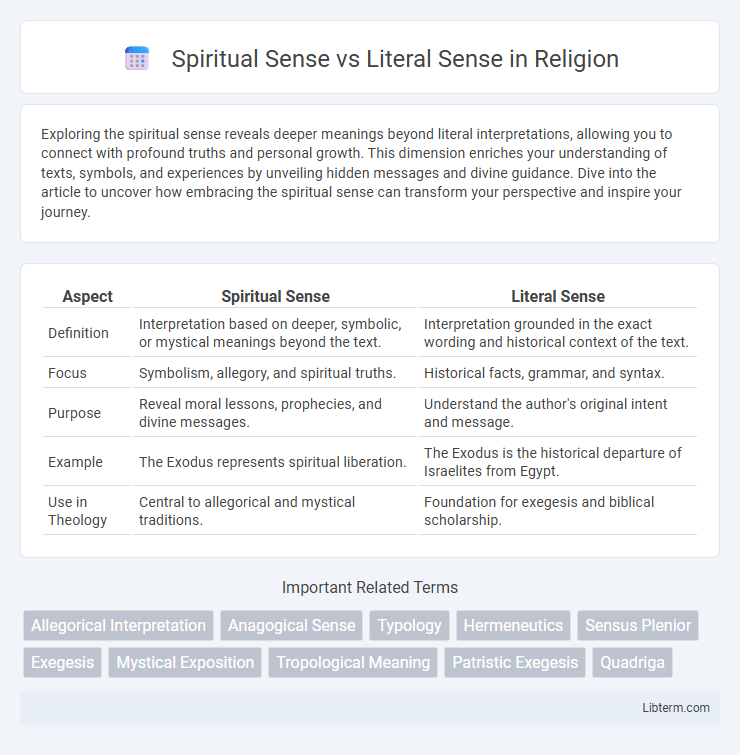Exploring the spiritual sense reveals deeper meanings beyond literal interpretations, allowing you to connect with profound truths and personal growth. This dimension enriches your understanding of texts, symbols, and experiences by unveiling hidden messages and divine guidance. Dive into the article to uncover how embracing the spiritual sense can transform your perspective and inspire your journey.
Table of Comparison
| Aspect | Spiritual Sense | Literal Sense |
|---|---|---|
| Definition | Interpretation based on deeper, symbolic, or mystical meanings beyond the text. | Interpretation grounded in the exact wording and historical context of the text. |
| Focus | Symbolism, allegory, and spiritual truths. | Historical facts, grammar, and syntax. |
| Purpose | Reveal moral lessons, prophecies, and divine messages. | Understand the author's original intent and message. |
| Example | The Exodus represents spiritual liberation. | The Exodus is the historical departure of Israelites from Egypt. |
| Use in Theology | Central to allegorical and mystical traditions. | Foundation for exegesis and biblical scholarship. |
Understanding Spiritual Sense and Literal Sense
Understanding the spiritual sense involves interpreting biblical texts by uncovering deeper symbolic meanings that reflect moral, allegorical, and theological truths beyond the literal words. The literal sense refers to the straightforward, direct meaning of the text as it was originally written and understood, focusing on historical context and factual information. Mastery of both spiritual and literal senses enhances comprehensive biblical interpretation, allowing for a richer grasp of scripture's multifaceted messages.
Historical Origins of Spiritual and Literal Interpretation
The historical origins of spiritual and literal interpretation trace back to early Judeo-Christian exegesis, where biblical texts were read both for their immediate, literal meaning and for deeper, allegorical or spiritual insights. Early Church Fathers such as Origen and Augustine emphasized the multi-layered approach to Scripture, distinguishing the literal sense as the foundational historical narrative from the spiritual senses--including allegorical, moral, and anagogical interpretations--that reveal theological and mystical truths. This dual framework established the groundwork for ongoing hermeneutical methods, influencing both medieval scholasticism and contemporary biblical studies.
Key Differences Between Spiritual and Literal Sense
The key differences between spiritual sense and literal sense lie in their interpretation of biblical texts: literal sense refers to the explicit meaning of the words as intended by the original author, focusing on historical and grammatical context. Spiritual sense encompasses deeper meanings, including allegorical, moral, and anagogical interpretations that reveal underlying spiritual truths and divine messages. Understanding these distinctions enhances biblical exegesis by integrating both the tangible narrative and its transcendent significance.
The Role of Context in Interpretation
The role of context in interpreting spiritual and literal senses is crucial, as the literal sense focuses on the precise meaning of the text within its historical and cultural setting. Spiritual sense interpretation goes beyond the immediate words to uncover deeper theological and moral significance, often requiring awareness of broader biblical themes and traditions. Contextual knowledge ensures accurate decoding of symbolism, allegories, and typologies, preventing misinterpretation and enriching understanding of scripture.
Examples of Spiritual Sense in Religious Texts
Spiritual sense in religious texts often reveals deeper, symbolic meanings beyond the literal words; for example, in the Bible, the story of the Exodus represents not just historical liberation but also spiritual salvation and deliverance from sin. The parables of Jesus illustrate moral and spiritual truths about the kingdom of God, encouraging believers to seek inner transformation rather than just external adherence to laws. Similarly, the allegory of the soul's journey in the Bhagavad Gita transcends the literal battle, symbolizing the internal struggle between duty, righteousness, and spiritual awakening.
Significance of Literal Sense in Scriptural Analysis
The literal sense in scriptural analysis serves as the foundational layer that conveys the explicit meaning intended by the original author, crucial for accurate interpretation of biblical texts. It anchors theological reflections by providing a clear context, historical background, and narrative structure necessary for understanding subsequent spiritual senses. Proper grasp of the literal sense prevents misinterpretation and ensures that allegorical, moral, and anagogical readings remain faithful to the scripture's true message.
Interpretive Methods: Allegory vs. Literalism
Spiritual sense interpretation emphasizes allegory, uncovering deeper symbolic meanings beyond the literal text, often used in biblical exegesis to reveal theological truths. Literalism focuses on the concrete, historical, and grammatical meaning of the text, adhering strictly to the original context and words. Allegorical methods interpret narratives as metaphors for spiritual realities, while literalism maintains that the text's plain meaning is the primary source of understanding.
Advantages and Limitations of Each Approach
The literal sense of a text provides a clear, direct interpretation grounded in the explicit meaning of words, ensuring accuracy and consistency in understanding historical and factual information. The spiritual sense explores deeper symbolic or allegorical meanings, enriching interpretation by connecting the text to broader theological or moral principles. Literal interpretation may limit insight to surface-level content, while spiritual interpretation risks subjective bias or overextension beyond the text's original context.
Modern Perspectives on Spiritual and Literal Senses
Modern perspectives on spiritual and literal senses emphasize the coexistence of both interpretations within religious texts, highlighting their complementary roles. Literal sense refers to the explicit meaning of words, grounded in historical and cultural context, while spiritual sense explores deeper symbolic or allegorical meanings relevant to personal and communal faith experiences. Contemporary scholars advocate integrating literary, historical, and theological methods to enrich understanding and foster dynamic engagement with sacred writings.
Navigating Conflicts Between the Two Approaches
Navigating conflicts between the spiritual sense and literal sense requires recognizing the intended message within scriptural texts and understanding their theological context. The literal sense emphasizes the explicit meaning of words and historical context, while the spiritual sense reveals deeper, metaphysical insights that convey moral or allegorical significance. Successful interpretation balances these approaches by respecting both literal accuracy and spiritual symbolism to achieve a comprehensive understanding of sacred writings.
Spiritual Sense Infographic

 libterm.com
libterm.com